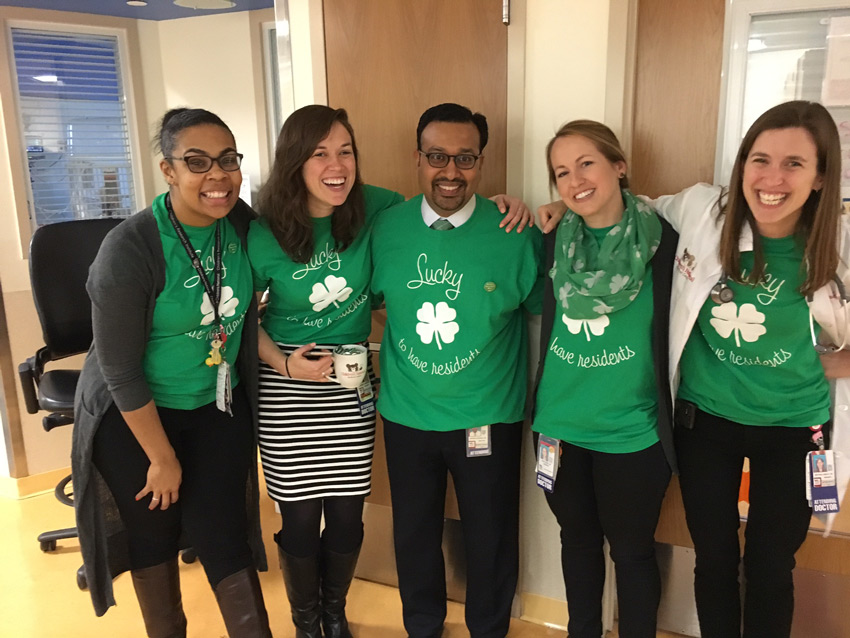Children’s National Research Institute Academic Annual report 2019-2020

Office of Medical Education
Vice Chair Keeps Trainees at the Heart of Medical Education
“I still get a little teary every time,” says Dewesh Agrawal, M.D., about attending pediatric residency program graduation at Children’s National Hospital.
Even though he’s watched more than 500 aspiring physicians pass through the program on their way to medical and research careers, he tries to maintain that connection and sense of fatherly pride for them.
His passion for the success of every resident he’s worked with as director of the pediatric residency program made him the perfect person to become vice chair of medical education at Children’s National in 2019. In this new role, he oversees more than 1,600 medical trainees — from medical students to pediatric residents and fellows in subspecialty pediatrics — each year.
Dr. Agrawal was fresh out of his own pediatric emergency medicine fellowship when he became rotation director for the residents’ emergency department (ED) rotation at Children’s National in 2004. To innovate the educational experience of residents on their ED rotation, he completed the Children’s National Master Teacher Leadership Development Program — one of the first hospital-based programs in the country aimed at helping pediatric specialists and subspecialists become educational scholars and exceptional teachers for their trainees.
He leveraged that master teacher experience when he took over as director of the pediatric residency program in 2007.
“We had a cadre of great educators in the hospital — which was unique because not many places in the country had the same institutional level of commitment to developing the faculty as educators,” he remembers. “So I thought, ‘Let’s find a way to engage them in redesigning the residency program’s curriculum to benefit the trainees as much as the program benefits the institution.’”
We had a cadre of great educators in the hospital — which was unique because not many places in the country had the same institutional level of commitment to developing the faculty as educators. So I thought, ‘Let’s find a way to engage them in redesigning the residency program’s curriculum."
Step one was engaging the residents to find out what they thought of the program and what it needed. At the time, he said, seeking input and feedback from the ground up was a different approach. Engaging master teachers to design the curriculum around the best educational experience possible and incorporating trainee feedback turned out to be a game-changer.
Today the institution’s commitment to both the individual development of each resident and the continuous feedback loop with current residents has helped Children’s National become a premiere destination for medical students seeking pediatric residency training. Last year, more than 2,000 students applied for one of the program’s 41 annual intern slots.

As vice chair of education, Dr. Agrawal now brings these same guiding principles to all of the hospital’s medical training programs and plans to renew the organization’s commitment to ensuring that the educational experience at Children’s National is the best in the country for all trainees.
One of the most promising developments he sees is a focus on interprofessional education, in which trainees from programs such as nursing, residency, psychology and pharmacy learn together in interdisciplinary care teams — mimicking the best practices many pediatric hospitals use in day-to-day bedside care.
“That’s how we deliver care, so why don’t we teach people how to do it from the start?” he asked. He predicted that in the next five years, this approach will become a hot topic and, possibly, a primary training approach in the top medical education programs.
“We provide better care when we’re all working together on the same page. If we can teach in that model, then it will be all that people know, and they will know it’s better from the start.”
The work has started under his supervision in the residency program, where training scenarios sometimes feature residents shadowing nurses and simulation scenarios in which nurses take on the physician role. Now, as vice chair, Dr. Agrawal is working with Children’s National chief nursing officer, Linda Talley, and nursing leadership to make interprofessional training a key facet of the educational strategic plan for the entire organization.
“We want to make this the premier training place for all of pediatrics. We have great data showing that how a practitioner performs in 10 to 20 years is determined by how he or she was trained,” he says. “If the goal is to improve patient care, we need to give the best and most innovative educational experience to all the trainees who come through our doors.”

